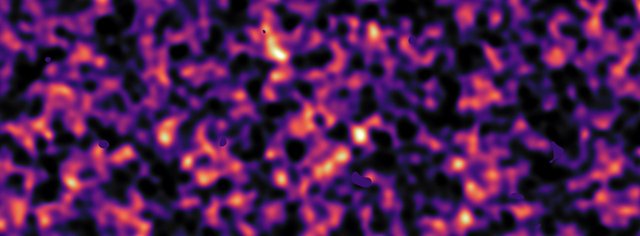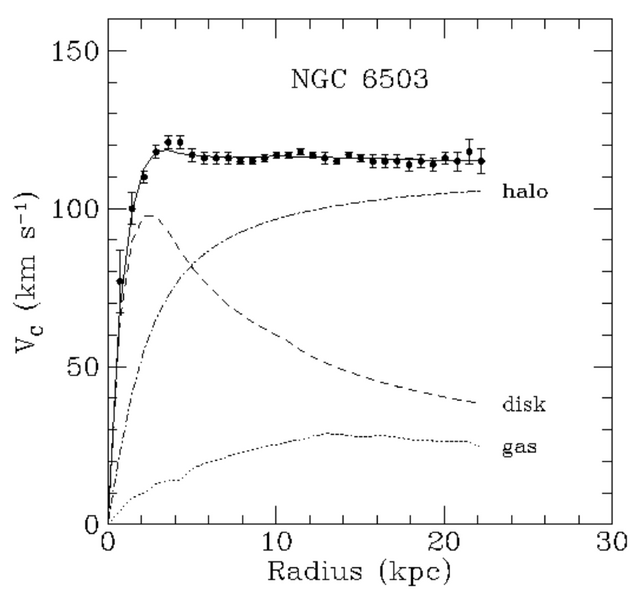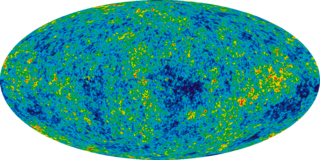Although I am a particle physicist, which is also known as a high-energy physicist, a large fraction of my research work focuses on the problematics of dark matter.

[image credits: Wikipedia]
A good question that may be asked for, is why the hell would someone interested by the smallest bits of matter may learn something from what is going on at the scale of the universe.
The answer is actually very simple and is based on only two assumptions.
With this article, I will try to explain why dark matter is important for particle physics, and I will focus, as an appetizer before the grande finale, on giving details on these two assumptions.
THE ORIGINS OF THE IDEA OF DARK MATTER
The first of these assumptions that I have mentioned above requires relies on the correctness of the dark matter paradigm. This is a very strong assumption, which I have already discussed in the past and that I will further discuss in this section.
As a good starting point, it is interesting to come back to where the dark matter idea is originally coming from. It is old, very old: it is already 85 years old.
The origins of the story comes from observations made in 1933 by Fritz Zwicky, who observed what was going on in a cluster of galaxies named the Coma Cluster.
Zwicky was actually not the first one to suggest the idea of dark matter, but he is the first one who brought on the table an indirect evidence of its existence.

[image credits: arXiv]
In a few words, Zwicky observed the circular motion of stars and gas in a distant galaxy, as a function of their distance from the galactic center.
Moreover, on the basis of the mass of these visible stars and gas and with the help of Newtonian dynamics, predictions can be made for the quantities being observed.
An illustration of the results is given in the picture on the left. The predictions consist of the ‘gas’ line, whilst the data are the squares.
A strong disagreement can be observed, which has been in the meantime confirmed by many independent measurements.
There are two generic solutions in order to restore agreement between theory and data.
Either we change how gravity works at large distances, or we add matter that interacts gravitationally but that is invisible (or dark).
Both options are still viable today and researchers are working on both. I will focus on the dark matter option. which is the one I prefer.
OTHER INDIRECT EVIDENCE FOR DARK MATTER
But that is not all the story concerning the current evidences for dark matter. More data is available, and dark matter is capable to accommodate a lot of data.
This is why dark matter is still very much studied today as a very serious hypothesis to explain what is going on in the universe.

[image credits: Wikipedia]
Let us list a few of these evidences.
On galactic scale, one can mention gravitational lensing, one of the predictions of general relativity (illustrated by the picture on the right).
Matter bends the trajectory of light between an emitter source and the observer (i.e., us). Studying how light is bended allows us to go back to the amount of matter that bended the trajectory, which consists another evidence for a missing mass.

[image credits: Wikipedia]
Another indication of dark matter may come from the cosmic microwave background. The latter is super well measured by in particular the Planck experiment (as shown in the picture on the left).
The anisotropies that can be observed on the picture can be traced back to test cosmological models, and thus indirectly to dark matter which is an important component of many cosmological models.
BEYOND THE STANDARD MODEL
Now it is time to move back to particle physics.
The second of the above-mentioned assumptions concerns the fact that the Standard Model of particle physics, which is one of the most tested theories of all time and which survives all tests so far, is only the visible part of the ultimate theory describing the world of the elementary particles.

[image credits: The Particle Adventure]
There are indeed strong hints yielding physicists to think that the Standard Model is not this ultimate theory of nature.
Just to quote a few of them, one can mention the unification of the fundamental interactions, gravity, the large hierarchy between the strength of gravity and of the other interactions, etc.
I have written an entire post on this topic in the past, which can be found here. So for more information, I am lazily referring to this post :)
There is actually a huge field of research focusing on the possible theories describing the microscopic world, but beyond the Standard Model.
In a few words, researchers investigate what are the possible signatures of any theory that can be seen as a more fundamental extension of the Standard Model, how such a theory could be seen in past, present and future experiments, and what novel phenomena should be expected or could be used for unraveling the true nature of the entire particle physics iceberg..
MERGING THE INFINITELY BIG AND SMALL
Of course, constructing a theory describing how the elementary particle speak with each other is not too complicated, at least for someone who studied that area of physics.
The basic ingredients are the same as those necessary for building the Standard Model: quantum field theory, special relativity, gauge symmetries, etc… Those are a lot of big words, but they are not very important for the discussion.
What is important is that nothing really fancy is necessary. Of course, once in a while a new ideas appear, but such ideas can always be linked to the same basic principles underlying the Standard Model.
What is complicated is that one must construct viable theories with respect to data. Let us focus on an example, the theory ‘A’.
Let us assume that I am a big fan of a specific theory named ‘A’. If ‘A’ predicts a spectacular signature that should have already been observed in experimental data from the last ten years, ‘A’ must go into the bin.
No discussion. Any realistic theory must agree with data. And this is where dark matter comes into the game.
Many theories extending the Standard Model contains a particle that can play the role of dark matter. As we have a dark matter candidate, this dark matter candidate must not contradict astrophysical and cosmological data..
This is why astrophysics and cosmology are important for the construction of theories potentially extending the Standard Model!
SUMMARY AND REFERENCES
With this article, I have tried top summarize why astrophysics and cosmology matters for particle physics. In short, I have tried to motivate why many researchers in particle physics think the universe is dark, and why it matters for particle physicists tracking new phenomena.
(I must admit I am proud of this last sentence :p )
To go one step further: I have tried to motivate why dark matter is now one of the central stone of the current high-energy physics research program.
From more information, I suggest the following readings:
- The article where Zwicky studied the Coma cluster is available here.
- The wikipedia page is pretty accurate and contains many many references. I am not a big fan of referring to wikipedia, but this time, an exception is in order. See here and references there in.
- For the reasons why one should go beyond the Standard Model of particle physics, I am self-citing myself with my old steemit article.
Hi again. I often think about the first three minute phase of the Universe. Physicist speak of different phase transitions from the singularity to the sudden expansion of space faster then the speed of light to the point were things are cooling down to allow particle production which we can than see in the picture you have shown above which depicts the Microwave Background Radiation. So I always see 4 things, 1- the vacuum energy, 2- space and its expansion, 3- matter, and the Planck scale. Here is my reverse thought, if space can expand faster then light, then it must start off cold and expand so long until it reaches high enough temperatures so that particles begin to condense or form. The particle production on the other hand is the mechanism which slows down the space expansion by basically curling up space into matter, otherwise this fast expansion phase would not come to a stop. Afterward the hot Universe would continue to cool down forming molecules just the way you guys describe it. There must be also some kind of correlation between the total amount of vacuum energy and matter for us to observe this. :-)
Downvoting a post can decrease pending rewards and make it less visible. Common reasons:
Submit
First, thanks a lot for this great comment (that is really appealing from a discussion standpoint)! I however must admit I am a bit lost with your comment :p
Let's start with a detail:
That is an artefact of things getting non-local. Galaxies very far from the observers seem to move faster than light, but there are very distant from each other too. As a result, we are not local. And speed is a local concept. Actually, this is the entire definition of 'speed' here that is tricky.
Here I have troubles to follow you. If the universe expands, it cools down. Also, the probability two particles meet to interact decreases. This is simplify the so-called freeze-out mechanism of dark matter. Nothing more nothing less. The particle density freezes.
How it this possible? How is particle production related to the expansion of the universe? Do you mind giving me more details here? Thanks in advance!
Downvoting a post can decrease pending rewards and make it less visible. Common reasons:
Submit
As soon as particle production starts, Gravity begins to exist, if you do not believe in a graviton particle. That is also why I have problems with the Higgs mechanism even though I can understand the concept. E=mc^2 . Mass is not for me a particle. Most of the mass comes from the binding forces which hold the Quarks together probably 99% or more. Binding force is Energy but in this case they are called Flex-Tubes (scroll down a little to see the picture) which hold the quarks together. This is how I visualize space expansion slowing down. It is converted into matter. You said that one might have to rethink gravity or think about Dark Matter. Wouldn't the Universe become opaque with all the Dark matter needed? These are just alternative thought to the subject in case the data is interpreted differently.
Downvoting a post can decrease pending rewards and make it less visible. Common reasons:
Submit
I am a bit confused by your answer. I am not sure to follow what you are explaining.
Gravity does not need particles to exist. It is there, and everything couples to gravity. Graviton is known as the potential particle mediating gravitational interactions, but it has not been observed up to now.
Now, to come back to the second point, mass in indeed not a particle. It is a property of each particle. It works both for elementary objects and composite systems. For the latter, the binding energy indeed plays a role.
Taking the quark example, protons hold together thanks to the strong force, via numerous quark and gluon exchanges. No gravity here. The role of gravity is exactly zero.
But all of this has nothing to do with the expansion of the universe. And the latter cannot be converted into matter. At least to my knowledge (please show me an article to read about that so that I could get further pieces of information).
Downvoting a post can decrease pending rewards and make it less visible. Common reasons:
Submit
I'm not surprised that you are confused with my reply. By training you are a Physicist, I am not. I can only simulate my thoughts and they always seem to come up with other perspective views. Have patients with me. You say everything couples to gravity, I take the view everything physical is gravitational. I am also aware that the potential gravity particle has not bin observed (yet). I agree with you that the strong forces which hold the quarks together have zero gravity, but the whole system in itself is again gravitational. Put it in an empty room with something nearby which has less mass, it will be attracted to the object with higher mass. The expansion of the Universe is trying to find equilibrium by falling to a lower energy state. Dose that mean that the vacuum energy, is a higher energy state? Spontaneous particles come into being and are annihilated with their counter parts in very small time intervals. As we know, mater without space is not possible and matter has to be some kind of derivative of space because both came from the same singularity. I have no literature on this subject. String theory likes to fold 11 dimensions also in theory. But when considering the Planck scale and the smallest known particles, there is lots of room for speculation. No need for a response, but I would love to hear one. I suppose its getting philosophical now. Thanks for your time. That is also why there must be some kind of correlation between our visible universe ( its mass ) and the vacuum energy state from which the singularity had its beginning or not.
Downvoting a post can decrease pending rewards and make it less visible. Common reasons:
Submit
The key point that may be missing in your reasoning is that the gravitational strength is proportional to the involved mass. The quark or proton masses are thus way too small to be gravitationally relevant. Even if a gravitational force exists, it can be approximated to zero compared to anything else.
Downvoting a post can decrease pending rewards and make it less visible. Common reasons:
Submit
I like discussing with you, I need people with expertise. It drives the thought process, but I will not take anymore time of yours except I have to comment on your last reply. I agree with you that on the particle level gravity is neglect-able, but it is the sum of the parts that make a difference as long as the individual parts are not zero. It seems to be similar with the Dark Matter problem and Dark Energy which is even larger. You are looking for small Anti-Particles which in the sum cause the orbits of the stars to be stable. The Dark Energy, … dose it have something to do with the vacuum energy? It (DE), some how is the reason that everything got started in the first place. I once visited the University for two months in Master Classes as a Guest (Germany Ulm) to find out why Professors think the way they do. Well if one can't model it with some algorithm you have a problem. That's my problem, I can't do the Math but I did learn a lot. It seems I would have to start from scratch but I'm too busy with the Cryptocurrencies. Thanks again it was a lot of fun for me.
Downvoting a post can decrease pending rewards and make it less visible. Common reasons:
Submit
To continue this discussion, this is true that gravity is important when many many particles are into the game. However, this is not the case here which is why gravity is totally ignored.
I am againnot sure to follow you when you reintroduce dark matter and dark energy, and i hence do not know what to say. You may need to clarify your thoughts first ;) apologies for this.
Anyhow, maybe discussing the basis as a start, when you will have more time, may help ^^
Downvoting a post can decrease pending rewards and make it less visible. Common reasons:
Submit
Nice article. While I was reading it I thought, well, if we theorize dark matter and dark energy are real and we can observe some effects which we attribute to them, is it possible that we can't see them because they live in a different dimension?
Thanks again for a great post!
....upvoted and resteemed!
Downvoting a post can decrease pending rewards and make it less visible. Common reasons:
Submit
In a few words, there are theories with extra dimensions and that explain why the universe is expanding as fast as we see it and that propose some dark matter candidates. The number of spatial dimensions is in this case larger than 3.
One way to see this is the following. The extra dimensions can be seen as hidden from us instead of being different from us. Think about a pencil. This is a 3D object. Now, ask a friend to hold the pencil for you and start moving away from it. You will see your 3D pencil appearing like a straight line (1D). That's basically what is going on with the extra dimensions.
Other setups are possible, with large (instead of compact) extra dimensions, but they seem less favored by current data. Moreover, this would not help to explain with his going on in our 3D world.
I hope this helps :)
Downvoting a post can decrease pending rewards and make it less visible. Common reasons:
Submit
Thanks, my friend!
Downvoting a post can decrease pending rewards and make it less visible. Common reasons:
Submit
Great article. What do you think about the superstring theory? I'd love to read an article about some kind of theory of everything written by you ;)
Downvoting a post can decrease pending rewards and make it less visible. Common reasons:
Submit
Superstrings and strings are actually a bit far from what I do and I actually do not know enough about them for allowing myself to write about that. Sorry :(
Downvoting a post can decrease pending rewards and make it less visible. Common reasons:
Submit
The dark matter based on what I've read is from the blackholes where in oppositely does what the blackhole does. It is the one that could create life and energy that is floating on space.
Downvoting a post can decrease pending rewards and make it less visible. Common reasons:
Submit
Black holes and dark matter have nothing to do with each other. And in any case, they are not connected to life creation.
Concerning energy creation, dark matter particles can annihilate and release energy. This is true.
Downvoting a post can decrease pending rewards and make it less visible. Common reasons:
Submit
You are very interesting to analyze and present the material, @lemouth. Tell accessible language about difficult things.
I agree, that the standard model has outlived its usefulness. And not able to accommodate all the accumulated knowledge about the universe. Waiting for the emergence of a new theory, that can explain all of this.
I hope, that we do not live in a simulation. And dark matter there is no Creator, which it did.))) Joke
Downvoting a post can decrease pending rewards and make it less visible. Common reasons:
Submit
A dark creator may be interesting to conceive ;)
Downvoting a post can decrease pending rewards and make it less visible. Common reasons:
Submit
Exactly. Hahahahaha
Downvoting a post can decrease pending rewards and make it less visible. Common reasons:
Submit
I'm studying physics, and I think next year I will study dark metter, so this is a good introduction. Great post
Downvoting a post can decrease pending rewards and make it less visible. Common reasons:
Submit
Which area of physics are you interested in? Any plans for the further future?
Downvoting a post can decrease pending rewards and make it less visible. Common reasons:
Submit
When I finish the degree I would like to do the master in astrophysics, it is the area that interests me the most.
Downvoting a post can decrease pending rewards and make it less visible. Common reasons:
Submit
That's a great domain of science! I wish your dreams will come true! :)
Downvoting a post can decrease pending rewards and make it less visible. Common reasons:
Submit
Thank you!
Downvoting a post can decrease pending rewards and make it less visible. Common reasons:
Submit
By the way, do not hesitate to join #steemSTEM where Steemit science lovers are chating together ^^
Downvoting a post can decrease pending rewards and make it less visible. Common reasons:
Submit
I did not know about that, I will start use it!
Downvoting a post can decrease pending rewards and make it less visible. Common reasons:
Submit
Great article!! Love learning about dark matter and especially the standard model. I'm even going back now to your old post to check it out! Keep it up :)
Downvoting a post can decrease pending rewards and make it less visible. Common reasons:
Submit
Don't hesitate to ask questions on the old posts too, if any. It will be my pleasure to come back to them :)
Downvoting a post can decrease pending rewards and make it less visible. Common reasons:
Submit
Why it MATTERS har har har har!
I don't have the energy for this.
Just came here from steemstem, following =D
Downvoting a post can decrease pending rewards and make it less visible. Common reasons:
Submit
Energy for what? Being dark or accreting more matter? :D
Downvoting a post can decrease pending rewards and make it less visible. Common reasons:
Submit
Wonderful and interesting read as usual, keep the good work! :D
Downvoting a post can decrease pending rewards and make it less visible. Common reasons:
Submit
You can count on me ^^
Downvoting a post can decrease pending rewards and make it less visible. Common reasons:
Submit
Can you recommend a lay-person's or college student level of you-tube video that can expand on how to apply dark matter to our evolution as a species.
Downvoting a post can decrease pending rewards and make it less visible. Common reasons:
Submit
I do not think this exists at all... How could dark matter help us to evolve?
Downvoting a post can decrease pending rewards and make it less visible. Common reasons:
Submit
Possibly not in the 3D, potentially in another dimension. Transmutation is a form of evolution.
Downvoting a post can decrease pending rewards and make it less visible. Common reasons:
Submit
Do you have any scientific article I could read on this, by any chance. I am not aware of any of this.
Downvoting a post can decrease pending rewards and make it less visible. Common reasons:
Submit
So you're saying it's not just a spaceship fuel?
Downvoting a post can decrease pending rewards and make it less visible. Common reasons:
Submit
It is not a spaceship fuel for sure, as we are not even sure it exists.
Downvoting a post can decrease pending rewards and make it less visible. Common reasons:
Submit
woah...complicated but quiet interesting
Downvoting a post can decrease pending rewards and make it less visible. Common reasons:
Submit
If you want more precision, don't hesitate to ask! This is where I may help ^^
Downvoting a post can decrease pending rewards and make it less visible. Common reasons:
Submit
sure just keep it up and continuous sharing.
Downvoting a post can decrease pending rewards and make it less visible. Common reasons:
Submit
Great blog, a lot of material I am excited to go through. Keep posting, I fully support what you are doing here.
Downvoting a post can decrease pending rewards and make it less visible. Common reasons:
Submit
Thanks a lot! :)
Downvoting a post can decrease pending rewards and make it less visible. Common reasons:
Submit